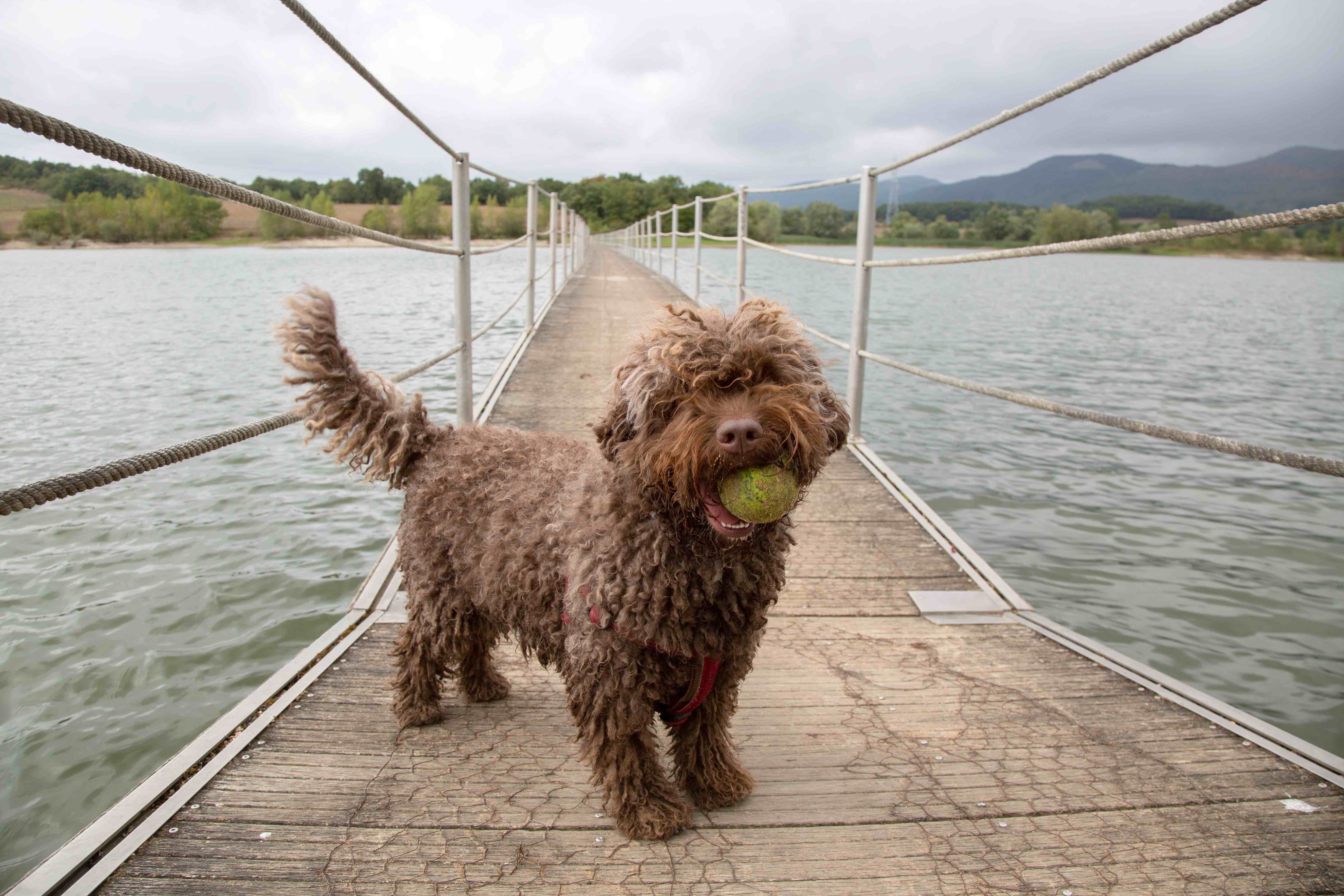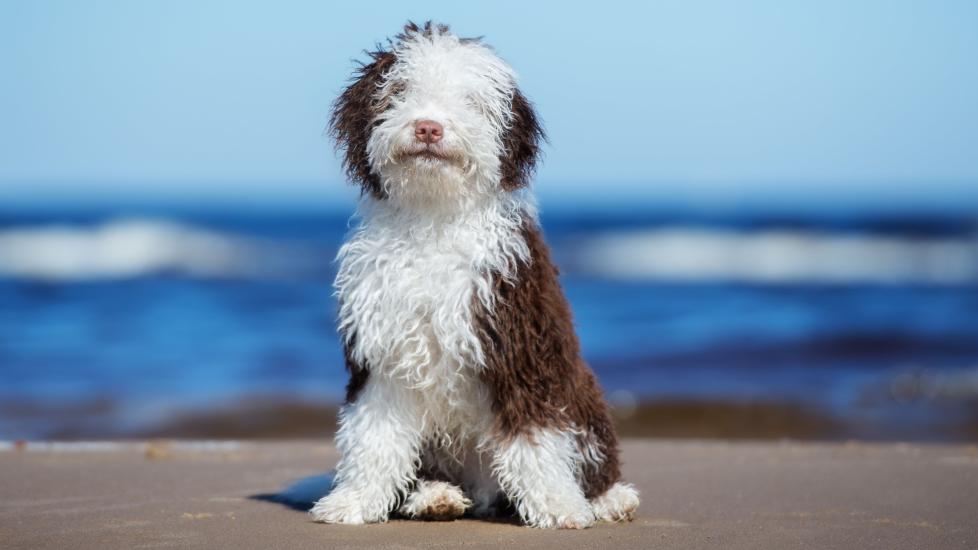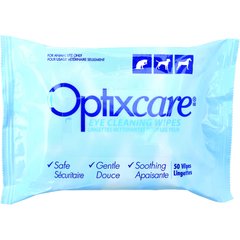Spanish Water Dog
Adobe Stock/otsphoto
For over 800 years, the Spanish Water Dog, also known as the Perro de Agua Español, has been a steadfast presence in the Spanish countryside. According to the Spanish Water Dog Club of America (SWDCA), the breed has a rich history as a versatile working dog, excelling in hunting, herding, and aiding humans as they fished. The dogs’ water-repellent coat suits them well for various weather conditions and water-related activities like swimming.
Spanish Water Dogs are a sturdy, athletic, medium-sized breed that typically stands 15–20 inches at the shoulder, weighs 31–49 pounds, and sports a distinctive curly coat in various colors such as black, brown, beige, and white. The loyal dogs are known for their friendly demeanor, and thrive with proper exercise and mental stimulation.
Caring for a Spanish Water Dog
The Spanish Water Dog temperament is upbeat, playful, and affectionate, making the dogs great companions for families. With a moderate energy level, this breed enjoys regular exercise but is also content to relax indoors. Their intelligence and eagerness to please make them relatively easy to train. As a working breed, Spanish Water Dogs thrive with tasks that stimulate their brain and keep them engaged.
Grooming is an important aspect of caring for a Spanish Water Dog, thanks to their curly coat.
Shop for Your Breed
- Optixcare Dog & Cat Eye Cleaning Wipes, 50 count$11.98Chewy Price
- Virbac Epi-Otic Advanced Ear Cleaner for Dogs & Cats, 4-fl oz bottle$12.34Chewy Price
- Virbac C.E.T. VeggieDent Fr3sh Dental Chews for Medium Dogs, 30 Count$31.79Chewy Price
- FURminator Short Hair Dog Deshedding Tool, Blue, Large$35.25Chewy Price
Spanish Water Dog Health Issues
Spanish Water Dogs are generally healthy dogs with an average lifespan of 12–14 years, which is typical for a medium-sized dog breed. But like all breeds, they may be predisposed to certain health issues.
Pet insurance may be a good investment when bringing home a Spanish Water Dog puppy, as it can help cover unexpected medical expenses. Talk to your veterinarian to see which insurance options are best for you.
Hip Dysplasia
Hip dysplasia is a common orthopedic condition in dogs. It occurs when the hip joint doesn't develop properly, leading to instability and degeneration over time. This causes discomfort, pain, mobility issues, and arthritis.
Management often involves weight management, exercise, physical therapy, and medication to alleviate pain. Pet parents should monitor their dog for signs of discomfort, such as limping or difficulty rising, and talk to their vet about any concerns.
Progressive Retinal Atrophy (PRA)
Progressive retinal atrophy, commonly referred to as PRA, is an inherited eye disorder that affects the retina, leading to progressive vision loss and eventual blindness. There’s no cure for PRA, but early detection through regular veterinary wellness exams can help manage the condition and slow its progression.
Hypothyroidism
Hypothyroidism is a common endocrine disorder in dogs, including Spanish Water Dogs, where the thyroid gland doesn't produce enough thyroid hormone. This deficiency can lead to a variety of symptoms, including weight gain, lethargy, hair loss, chronic ear infections, and skin issues.
Diagnosis involves blood tests to measure thyroid hormone levels. Treatment requires lifelong medical management.
Congenital Hypothyroidism with Goiter (CHG)
Congenital hypothyroidism with goiter (CHG) is a rare inherited disorder in Spanish Water Dogs, characterized by an underactive thyroid gland and an enlargement (goiter) due to inadequate thyroid hormone production from birth.
According to the breed club, CHG is caused by inadequate thyroid hormone production and is generally detectable in Spanish Water Dog puppies within the first two weeks of life. Symptoms may include stunted growth, lethargy, poor muscle development, and developmental delays.
What To Feed a Spanish Water Dog

When selecting dog food for a Spanish Water Dog, it's essential to prioritize a balanced and high-quality diet that meets their nutritional needs.
Choose high-quality dog food that meets the Association of American Feed Control Officials (AAFCO) nutritional requirements. By doing so, pet parents can help ensure their Spanish Water Dog stays healthy.
How To Feed a Spanish Water Dog
Consider your dog’s life stage when determining their diet. Spanish Water Dog puppies have different nutritional needs than adults, and senior dogs may require their own specially formulated food. Talk to your veterinarian about the best puppy food, adult food, and senior food for your dog.
How Much Should You Feed a Spanish Water Dog?
Establishing a consistent feeding routine is vital for Spanish Water Dogs to support their overall health and well-being. Typically, they do well with two meals per day, evenly spaced to maintain stable energy levels and prevent overeating. Spanish Water Dog puppies may require more frequent feeding to support growth.
When determining the right amount to feed your dog, consider factors such as age, weight, activity level, and caloric content of your dog food. Your veterinarian can provide the best guidance on portion sizes, and most food labels also offer recommendations.
Nutritional Tips for Spanish Water Dogs
Before adding supplements to your Spanish Water Dog’s regimen, consult with a veterinarian. Dogs eating an AAFCO-compliant food are already receiving the nutrients they need, but your vet may recommend supplementation depending on your dog’s health. These may include:
-
Omega-3 fatty acids (fish oil) to promote a healthy skin and coat, as well as supporting kidney, heart, and brain function
-
Joint supplements containing glucosamine and chondroitin to support joint health
-
Probiotics to maintain a healthy balance of gut bacteria and boost the immune system
Behavior and Training Tips for Spanish Water Dogs
Spanish Water Dog Personality and Temperament

Known for their friendly and affectionate temperament, Spanish Water Dogs thrive as family companions. When properly socialized from a young age, these dogs are generally good with other pets and children. However, pet parents may need to teach their dog that kids and the family cat are not something to herd.
Spanish Water Dogs are energetic and have a strong work ethic. Because of their history as working dogs, they’re happiest when they have a job to focus on, even if it’s just working through a puzzle toy.
Spanish Water Dog Behavior
According to the breed club, Spanish Water Dogs typically aren't prone to fearfulness, but anxiety may arise in some dogs if they’re not properly socialized.
While not excessive barkers, Spanish Water Dogs may vocalize to alert or express excitement, and like many breeds, they may dig if bored. The breed club recommends supervising your Spanish Water Dog when they’re in the yard so they don’t jump over or dig under the fence to explore the neighborhood (or try herding cars).
Spanish Water Dog Training
Always use positive reinforcement methods with ample praise and treats when training a Spanish Water Dog. The SWDCA recommends crate training your Spanish Water Dog puppy, as this can help with house training and with getting your pup into a routine.
Begin socializing your Spanish Water Dog as soon as you bring them home. Exposure to new people, animals, sounds, and situations will help your puppy grow into a calm and confident dog.
Fun Activities for Spanish Water Dogs
-
Agility
-
Obedience training
-
Nose work
-
Tracking
-
Retrieving games
-
Water sports
-
Trick training
Spanish Water Dog Grooming Guide
Spanish Water Dogs have a unique, curly, and water-repellent coat that requires regular grooming to prevent matting. While the breed doesn’t shed heavily, clipping is necessary to maintain the coat's health and appearance.
Skin Care
Spanish Water Dogs typically do not require special skin care beyond regular grooming. However, as with any breed, pet parents should monitor their dog’s skin for any signs of irritation, dryness, or inflammation.
Bathing should be done as needed, using a mild, dog-friendly shampoo to prevent stripping the natural oils from their skin and coat. According to the breed club, their coat should not be harshly scrubbed or dried with a towel, as this can cause matting. Instead, wash your Spanish Water Dog like a sweater: squeeze the water and shampoo through the fur, and let your dog air dry.
Coat Care
Spanish Water Dogs require regular coat care to keep their curly, water-repellent hair in good condition. The dog’s coat must be clipped evenly at least once a year, though some are clipped up to three times a year.
Unlike other dog breeds, Spanish Water Dogs should never be brushed or combed, according to the SWDCA. If your dog’s hair begins to mat, gently work the clumps out with your fingers.
When clipped, the Spanish Water Dog’s short fur makes them easier to care for, but you can also allow your dog’s hair to grow longer and develop cords, similar to the Komondor or Puli dog breeds.
Eye Care
Spanish Water Dogs don’t typically require special eye care. Monitor your dog’s eyes for signs of irritation, discharge, or redness, which could indicate an underlying issue.
Ear Care
Spanish Water Dogs require routine ear care to prevent infections and maintain ear health; this breed can easily develop ear infections thanks to their floppy ears and tendency to love water. Pet parents must clean their dog’s ears regularly with a veterinarian-recommended ear cleaner. Talk to your vet about how often you should clean your pup’s ears.
Considerations for Pet Parents
Before bringing home a Spanish Water Dog puppy, it's important to consider the ideal environment and care requirements for this breed. Spanish Water Dogs thrive in homes that provide both mental and physical stimulation through activities like obedience training and swimming. With their curly coat, they require a specialized grooming routine.
With the proper care and environment, Spanish Water Dogs make loyal and affectionate family dogs.
Spanish Water Dog FAQs
Are Spanish Water Dogs good pets?
Yes, Spanish Water Dogs can be excellent pets for active families who can meet the dogs’ needs for exercise, training, and socialization.
How much does a Spanish Water Dog cost?
A Spanish Water Dog’s price varies depending on factors such as the breeder's reputation, the dog's pedigree, and geographic location. On average, you can expect to pay anywhere from $1,500 to $3,000 for a Spanish Water Dog puppy from a reputable breeder.
Are Spanish Water Dogs high-maintenance?
Spanish Water Dogs can be moderately high-maintenance due to their grooming needs and energetic nature.
Are Spanish Water Dogs hypoallergenic?
Spanish Water Dogs are sometimes considered hypoallergenic because they have hair instead of fur, which means they shed less dander. However, no dog breed is entirely hypoallergenic, as individual reactions can vary.
What’s the difference between Spanish Water Dogs and Portuguese Water Dogs?
Spanish Water Dogs and Portuguese Water Dogs are distinct breeds with differences in origin, coat type, size, and temperament.
-
Spanish Water Dogs originated in Spain and were used primarily for herding and retrieving, while Portuguese Water Dogs originated in Portugal and were historically used by fishermen.
-
Spanish Water Dogs have dense, wooly coats that form cords or curls, while Portuguese Water Dogs have single-layered, curly coats that are typically clipped shorter.
-
Portuguese Water Dogs are generally larger and may have a more spirited temperament.




